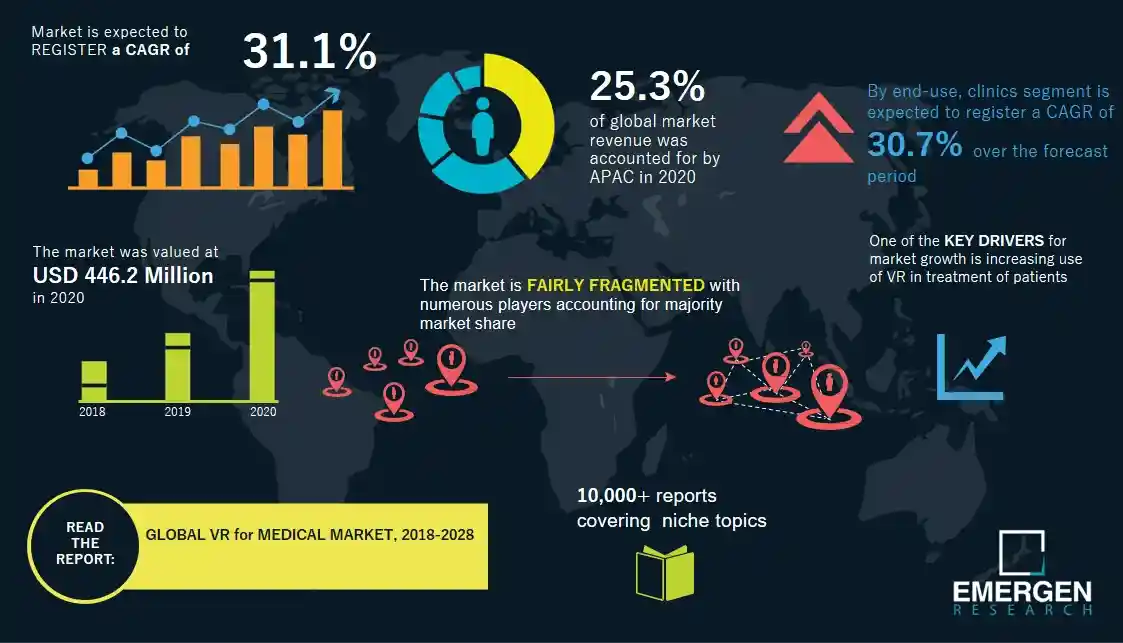
Virtual Reality in Medical Market Size to Reach USD 3,309.9 Million in 2028
The global virtual reality medical market size was USD 446.2 million in 2020. Increasing use of VR in the treatment of patients, rising focus on digitalization in the healthcare sector, growing healthcare expenditure, supportive government initiatives, rising prevalence of diseases, and growing use of VR in medical marketing are factors driving VR in medical market revenue growth, according to Emergen research reports.
Drivers: Growing use of VR for providing training to healthcare service providers
Use of VR for providing training to healthcare service providers without the need for an actual patient, such as in case of a surgeon getting trained on-job during a complicated surgery, is among some of the key factors driving preference and is a major driver for VR in medical market revenue growth. This technology also helps emergency care providers, or ‘ECPs‘ to learn how to appropriately carry out cardiopulmonary resuscitation (CPR) procedures without performing chest compressions on an individual having trouble breathing. Medical professionals can receive other beneficial training through VR, including learning about infectious disease control and human anatomy.
Restraints: Technical limitations in various healthcare facilities associated with implementation of Virtual Reality
Technical limitations in various healthcare facilities associated with the implementation of VR could hamper market revenue growth to some extent over the forecast period. In some clinical settings, size of VR systems might limit smooth operation. Likewise, for certain healthcare facilities, resolution and specification of computer systems can restrict deployment. Also, as digitalization is still an emerging concept in the healthcare sector, especially in some developing and underdeveloped economies, there is a lack of skilled professionals for the operation of such systems.
Growth Projections
The global Virtual Reality (VR) in the medical market is expected to reach USD 3,975.0 Million in 2028 and register a revenue CAGR of 31.1% over the forecast period. The rising focus on pain management and the benefits of VR for pain relief therapy and treatment is fueling revenue growth of the global VR in the medical market. Pain treatment varies in complexity, and more intricate procedures may comprise a series of muscle, nerve, or drug therapies. VR is an effective means of treatment than some other methods, as it reduces the need for or use of medication. VR provides a relaxing, entertaining, interactive, and immersive environment to patients to make them feel refreshed and thus ease pain.
COVID-19 Direct Impacts
During the coronavirus pandemic, researchers across the globe emphasized on use of innovative technologies, such as virtual reality for fast-tracking, to curb the spread of disease. Virtual reality is advantageous for remote or far-flung sites for exploring telemedicine, preparation, treatment, and regulating infections by delivering proper awareness to individuals about disease. This technology creates a platform to cut down face-to-face interaction of healthcare professionals with COVID-19 patients. Also, through live video streaming facility, VR aids to enhance surveillance systems on the current situation. Virtual Reality in Medical Market
Current Trends and Innovations
The rising deployment of virtual reality in mental healthcare therapy and applications is another key factor boosting demand in the medical sector. According to a study, Virtual Reality Exposure Therapy (VRET) is proving to be very effective for behavioral treatment associated with Post-Traumatic Stress Disorder (PTSD), which affects around 3.6% of the adult population in the US. Distinctive symptoms of PTSD include anxiety, nightmares, flashbacks, and altered perception of reality. VRET aids to eliminating or reducing these symptoms by offering a sensory and immersive atmosphere, thus making people shift their attention from traumatic experiences.
Geographical Outlook
Virtual Reality (VR) in the medical market in Asia Pacific is expected to register the fastest revenue CAGR over the forecast period, attributed to the presence of a large pool of patients, increasing focus on the development of healthcare infrastructure, and rising prevalence of diseases. Additionally, rising disposable income among individuals in countries in the region is expected to support Asia Pacific market revenue growth.
Strategic Initiatives
In October 2021, Sumitomo Dainippon Pharma Co., Ltd. made an announcement about signing a definitive partnership agreement with BehaVR, Inc. for the development and commercialization of general wellness products and prescription digital therapeutics to treat Generalized Anxiety Disorder (GAD), Social Anxiety Disorder (SAD), and Major Depressive Disorder (MDD) to tackle mounting depression and anxiety crisis worldwide.
Some Key Highlights From the Report
- Among the technology segments, the head-mounted technology segment accounted for the largest revenue share in 2020. Head-mounted technology products, such as Oculus Rift, Gear VR, HTC Vive, or Google Cardboard, possess a head strap mounted on the head of the user, with earphones and display lenses attached to the strap. This technology delivers an immersive virtual reality experience by placing virtual objects in front of the wearer. VR head-mounted displays may be employed as a therapeutic medium for purposes of physical rehabilitation owing to the ability to provide an immersive environment to patients in controlled, safe, and engaging virtual worlds.
- Virtual reality headsets are deployed in healthcare facilities to distract children from the pain they may experience during flu shots, blood tests, and various other medical procedures.
- Among the end-use segments, the hospital segment accounted for the largest revenue share in 2020. This can be attributed to the high adoption and deployment of virtual reality systems in hospitals, owing to factors such as higher purchasing power, well-resourced operating and diagnostic rooms, the availability of highly skilled healthcare professionals, and better health coverage for healthcare services provided by hospitals from various group and private insurance plans. Virtual Reality in Medical Market
Some major companies included in the global virtual reality (VR) in the medical market are Microsoft Corporation, Koninklijke Philips NV, Firsthand Technology Inc., Orca Health Inc., General Electric, Alphabet Inc., AppliedVR Inc., SyncThink Inc., Osso VR Inc., and EchoPixel Inc.










